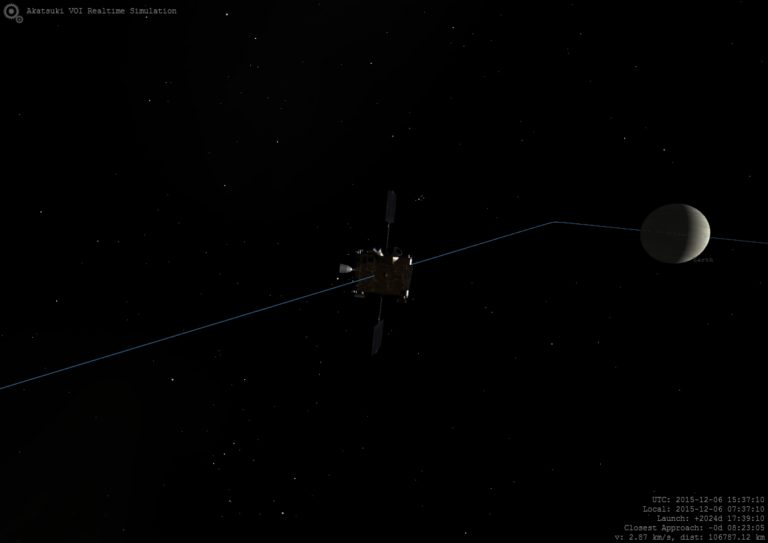Sanjay Limaye • Dec 06, 2015
Live from Sagamihara: Akatsuki Orbit Insertion - Second Try
December 5, 2015, 10:00 a.m. A beautiful sunny Saturday morning in Tokyo. I land at Narita airport and travel by train and taxi to the Institute of Space and Astronautical Science (ISAS) in Sagamihara, the nerve center for Akatsuki. Hiroki Ando from the Akatsuki project is waiting to meet me. I drop off my luggage and receive my badge that will give me access to the Akatsuki Project Area.
We walk past the Control Room where I see Project Manager Masato Nakamura looking at the consoles. There are screens projecting lots of information about Akatsuki spacecraft. We proceed to the support room where I see some familiar faces. Takeshi Imamura is working away on his laptop across from another Akatsuki scientist in the central area. He greets me and informs me that he is just in the process of uploading generating commands for changing the attitude of the spacecraft as it closes in on Venus for the 1233-second-long burn. I learn that the cameras were turned on a few days earlier and some images of Venus were obtained when the spacecraft was about twice as far away as the expected apoapsis distance on the capture orbit. I cannot wait to see the images. Feeling guilty about taking his time, we express our optimism for a successful couple of days and proceed to meet other scientists working on Venus.
Entering the room, I am greeted by Javier Peralta, who arrived from Portugal nine months ago. Hearing our voices, Yeon Joo peeked form behind the partition and is surprised to see me. She came to ISAS to work on Akatsuki data after getting her Ph.D. from Max Planck Institute in Lindau from analysis of Venus Express data two years ago. I mention to her that I was reading her recent article on analysis of Venus Monitoring Camera images. It has been more than a year since I had talked to these colleagues, so we discuss new developments on Venus and discuss what we can learn from Akatsuki.
December 6, 10:00 a.m.
I walk over to the Akatsuki Control Room. Approaching the building I notice a van drop off cameramen and other media persons at the entrance. From behind the glass window, I can see the Masato Nakamura looking a the screens and then the media team arrives to interview him, so I stepped away to the combination work and break room for the team. I notice a foreign person in the room and wonder if he is from JPL, but he looked busy, so I walk over to the Akatsuki Project area to see what is going on there. I am greeted by Takehiko Satoh and Shoko Ohtsuki. Takehiko Satoh is the Principal Investigator for one of the two short-wave infrared cameras on Akatsuki. He is working on generating commands for post VOI actions, so I do not want to interrupt his work. He tells me that the spacecraft attitude was changed successfully this morning to put it into the correct orientation for the orbit insertion thrust to be produced by the four thrusters on December 7.
I return to the Control Room area and meet the foreigner in the room. Indeed, he turns out to be an American, from JPL. A Flight Path Control Analyst, he is here to support the Akatsuki orbit insertion. He and his Japanese colleague have the critical task of determining how successful the thrust from the attitude control rockets has been. They will use the tracking data after the 1233-second burn to detect a small change in the Akatsuki position relative to Venus after the burn. The change is very small, so it will take some time to determine the orbit, approximately two hours before a change can be detected.
Suddenly Masato Nakamura walks into the room. He has been here since 4 am. I congratulate him on the progress so far and ask him if he is concerned about anything. He smiles and I learn that there are five critical events before tomorrow’s burn and Akatsuki has successfully accomplished two already. Casually he asks me if I have seen the images of Venus taken a few days earlier, and when I respond no, he allows me a peek at two of them and they are beautiful view of Venus at almost half phase. Only about half as large as the size they would be from the capture orbit at apoapsis. The pictures will be released tomorrow.
I spend lunch discussing Venus clouds and old and new results with colleagues. As I walk back to ISAS, I notice a person wearing an ISAS visitor's badge walking towards me. Curious, I ask if she came because of Akatsuki. Communication was difficult due to the language barrier, but I confirmed that she was aware of the Akatsuki orbit insertion tomorrow and inquire if she was going to look at Venus on Monday morning through the telescopes being set up at the museum across from ISAS. I learned that she could not as she is a high school teacher at a high school for physically disabled students in Machida. Pleased that there is anticipation about Akatsuki, I walk back to the Project Support area.
Later in the evening, Shoko Ohtsuki comes by and gives me a time line and a link to see a live animation of Akatsuki's position. As of 8:45 p.m., Akatsuki was less than 150,000 km away from Venus, closing in at about 2.6 kilometers persecond.

Let’s Go Beyond The Horizon
Every success in space exploration is the result of the community of space enthusiasts, like you, who believe it is important. You can help usher in the next great era of space exploration with your gift today.
Donate Today

 Explore Worlds
Explore Worlds Find Life
Find Life Defend Earth
Defend Earth

